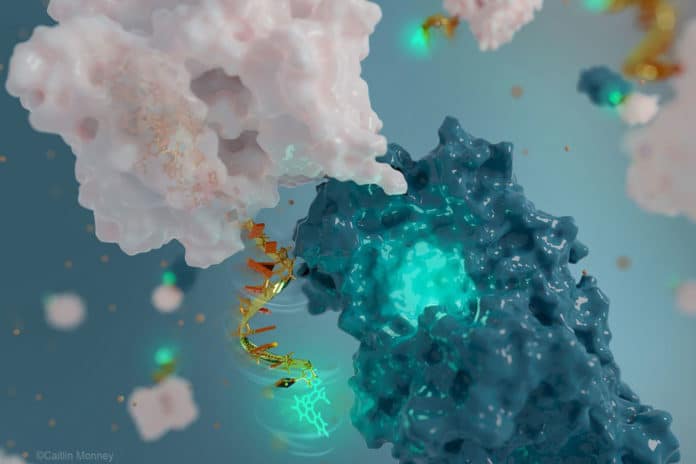In recent years, scientists realized that DNA could be used to build a variety of nanostructures and nanomachines.
In a new study, scientists at Université de Montréal have used DNA to build the world’s tiniest antenna. They created this nanoantenna to monitor the structural change of proteins over time.
This DNA-based fluorescent nanoantenna was built by taking inspiration from the ‘Lego-like’ properties of DNA. The nanoantenna can help scientists characterize the function of proteins.
UdeM chemistry professor Alexis Vallée-Bélisle said, “Like a two-way radio that can both receive and transmit radio waves, the fluorescent nanoantenna receives light in one color, or wavelength, and depending on the protein movement it senses, then transmits light back in another color, which we can detect.”
“One of the main innovations of these nanoantennae is that the receiver part of the antenna is also employed to sense the molecular surface of the protein studied via molecular interaction.”
Scott Harroun, an UdeM doctoral student in chemistry and the study’s first author, said, “One of the main advantages of using DNA to engineer these nanoantennas is that DNA chemistry is relatively simple and programmable.”
“The DNA-based nanoantennas can be synthesized with different lengths and flexibilities to optimize their function. One can easily attach a fluorescent molecule to the DNA, and then attach this fluorescent nanoantenna to a biological nanomachine, such as an enzyme.”
“By carefully tuning the nanoantenna design, we have created five nanometer-long antenna that produces a distinct signal when the protein is performing its biological function.”
The fluorescent nanoantennas could have important implications in biochemistry and nanotechnology. Using it, scientists were able to detect the function of the enzyme alkaline phosphatase with a variety of biological molecules and drugs.
Harroun said, “This enzyme has been implicated in many diseases, including various cancers and intestinal inflammation.”
Dominic Lauzon, a co-author of the study doing his Ph.D. in chemistry at UdeM, said, “In addition to helping us understand how natural nanomachines function or malfunction, consequently leading to disease, this new method can also help chemists identify promising new drugs as well as guide nano engineers to develop improved nanomachines.”
Vallée-Bélisle said, “Perhaps what we are most excited by is the realization that many labs around the world, equipped with a conventional spectrofluorometer, could readily employ these nanoantennas to study their favorite protein, such as to identify new drugs or to develop new nanotechnologies.”
Journal Reference:
- Harroun, S.G., Lauzon, D., Ebert, MCCJC et al. Monitoring protein conformational changes using fluorescent nanoantennas. Nat Methods 19, 71–80 (2022). DOI: 10.1038/s41592-021-01355-5
